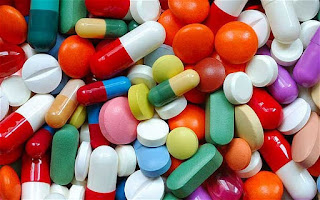Enoxaparin
"Clexane '
Trade name: Lovenox
Drug classes
• Low-molecular-weight heparin
• Antithrombotic agent
Pregnancy: (Category B)
Therapeutic
actions
Low molecular weight heparin that inhibits
thrombus and clot formation by blocking factor Xa, factor IIa, preventing the
formation of clots.
Indications
• Prevention of deep vein thrombosis, which may lead to pulmonary
embolism following hip replacement, knee replacement surgery, abdominal surgery
• Prevention of ischemic complications of unstable angina and
non---Q-wave MI
• Treatment
of deep vein thrombosis (DVT), pulmonary embolus with warfarin
Contraindications/cautions
• Contraindications:
hypersensitivity to enoxaparin, heparin, pork products; severe thrombocytopenia;
uncontrolled bleeding.
• Use cautiously with pregnancy or
lactation, history of GI bleeding.
Dose
Prophylaxis of deep-vein
thrombosis in medical patients, by subcutaneous injection, 40 mg
(4000 units) every 24 hours for at least 6 days until patient
ambulant (max. 14 days)
Treatment of deep-vein thrombosis or pulmonary embolism,
by subcutaneous injection, 1.5 mg/kg (150 units/kg) every 24 hours, usually for
at least 5 days (and until adequate oral anticoagulation established)
Unstable angina and non-ST-segment-elevation
myocardial infarction, by subcutaneous
injection, 1 mg/kg (100 units/kg) every 12
hours usually for 2–8 days (minimum 2 days) Adverse effects
• Hematologic: Hemorrhage; bruising; thrombocytopenia; elevated
AST, ALT levels; hyperkalemia
• Hypersensitivity: Chills, fever, urticaria, asthma
• Other: Fever; pain; local irritation, hematoma, erythema at site
of injection
Clinically important interactions
• Drug-drug
v Increased bleeding tendencies with oral anticoagulants,
salicylates, penicillins, cephalosporins
• Drug-lab test
v Increased AST, ALT levels
• Drug-alternative therapy
v Increased risk of bleeding if combined with chamomile, garlic,
ginger, gingko, and ginseng therapy
Nursing
Considerations
• Give drug as soon as possible after hip surgery.
• Give deep SC injections; do not give
enoxaparin by IM injection.
•
Administer by deep SC
injection; patient should be lying down. Alternate between the left and right
anterolateral and posterolateral abdominal wall. Introduce the whole length of
the needle into a skin fold held between the thumb and forefinger; hold the
skin fold throughout the injection.
•
Apply pressure to all
injection sites after needle is withdrawn; inspect injection sites for signs of
hematoma; do not massage injection sites.
• Do not mix with other injections or infusions.
• Store at room temperature; fluid should be clear, colorless to
pale yellow.
•
Provide for safety measures
(electric razor, soft toothbrush) to prevent injury to patient who is at risk
for bleeding.
• Check patient for signs of bleeding; monitor blood tests.
• Alert all health care providers that patient is on enoxaparin.
•
Discontinue and initiate
appropriate therapy if thromboembolic episode occurs despite enoxaparin
therapy.
• Have protamine sulfate (enoxaparin antidote) on standby in case
of overdose.
• Treat overdose as follows: Protamine sulfate (1% solution). Each
mg of protamine neutralizes 1 mg enoxaparin. Give very slowly IV over 10 min.



